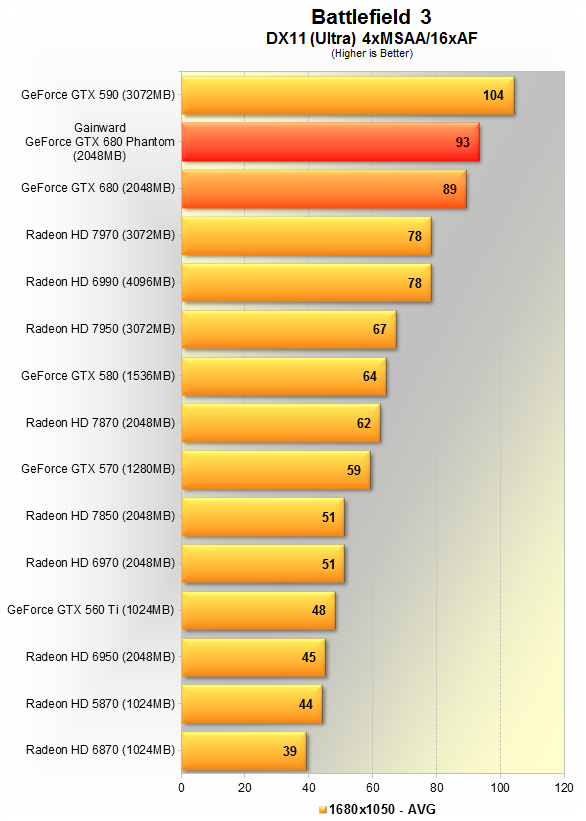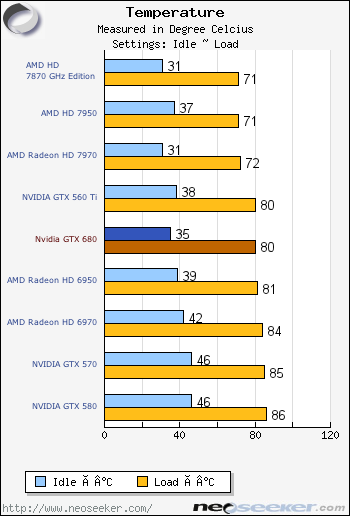

The idea behind this is pretty straightforward, working as a graphics core equivalent to the Turbo Boost technology added to recent Intel processors.

One of the most interesting advances made with the new Kepler architecture is the inclusion of an auto-overclocking mechanism, dubbed "GPU Boost". "The new GPU Boost technology dynamically overclocks the graphics card if the current game is not making the most of the default clock speed." Acoustic dampening materials are added to the fan itself to reduce noise still further. The smaller, cooler chip is backed up by a triple heat-pipe design that is complemented by a heat sink with a custom fin stack "shaped for better air-flow", according to NVIDIA. The old GTX 580 was a fairly quiet card even under load, but its replacement produces significantly less noise. This drive for efficiency yields dividends elsewhere. This reduction in power draw is such that NVIDIA is happy to recommend a 550W power supply for running a GTX 680 system. The GTX 680 harkens back to earlier NVIDIA graphics cards, only requiring two six-pin inputs, thanks to the drop in the chip TDP from 250W down to 195W. Top-end GPUs in recent times have required the use of both eight-pin and six-pin PCI Express power from the PSU. The GTX 680 is capable of running four displays simultaneously - the DVIs and DisplayPort can be used for triple-screen surround gaming in both 2D and 3D, while the final output can be used for monitoring background apps.Īnother change comes from the power socket allocation.
#NVIDIA GTX 680 BENCHMARKS PLUS#
First up, the number of display outputs has been boosted: the old combo of dual DVIs with a mini HDMI output has been given the push in favour of two DVIs, a full-size HDMI socket plus a brand new DisplayPort output. However, there are a number of changes and improvements over the old GTX 580 that are worthy of comment, translating into useful gameplay features. On first glance, there's little to differentiate the GTX 680 from any other enthusiast dual-slot graphics card.
#NVIDIA GTX 680 BENCHMARKS PC#
"Moore's Law has historically been driven by lower fabrication processes - and the transition to 28nm is set to power next-gen visuals on both PC and the new wave of consoles." However, in the here and now, the GTX 680 is the new state-of-the-art. The GTX 680 is smaller, leaner, cooler (it really is very quiet indeed for a high-end GPU) and more efficient, and there's headroom left over in the technology for an even more monstrous processor - already rumours are circulating of a 2304 core, 3GB ultra high-end card, with the 384-bit bus restored and 3GB of GDDR5 RAM on tap.


The gain in performance is also excellent - something we'll look at later on, but the basic facts speak for themselves. Also intriguing is that the memory bus is actually reduced from 384-bit in the GTX 580 down to 256-bit. It features a mammoth 1536 CUDA cores, up from 512 (though the design is very different, so the cores are not directly comparable), while GDDR3 gets upgraded from 1.5GB to 2GB, with RAM speed now reaching 6GHz - a remarkable achievement. Die-size drops from 520mm squared down to 295mm squared, yet the transistor count rises from 3bn up to 3.5bn. The GTX 680 offers approximately twice the performance per watt consumed compared to its illustrious predecessor, the GTX 580. Moore's Law has historically been driven by lower fabrication processes - and the transition to 28nm is what will power next-gen visuals on both PC and console.
#NVIDIA GTX 680 BENCHMARKS SERIES#
Prior to the release of this new technology, recent GPU upgrades for PC haven't exactly shown enormous levels of improvement (indeed the Radeon 6x00 series cards were in some ways slower than their predecessors) and one of the main reasons behind this was the fact that both AMD and NVIDIA were only able to fabricate their silicon at 40nm. It's a lofty claim but testing bears it out: NVIDIA's new "Kepler" architecture is truly something special, setting the stage for the next era in graphical performance. NVIDIA claims that its new GTX 680 is the fastest and most power-efficient GPU ever made, offering significant performance improvements over its competition - and indeed its own range of current flagship products - while at the same time reducing the amount of juice it saps from the mains. The era of the next-generation graphics core is finally upon us.


 0 kommentar(er)
0 kommentar(er)
